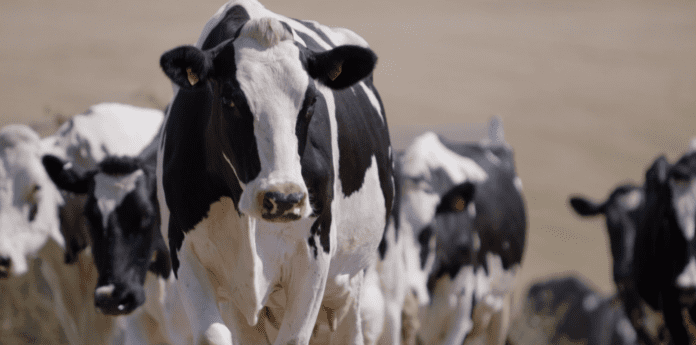Small changes to the routine around milking can have a big impact on cow flow and milk let-down on dairy farms.
During a recent Farming Connect webinar, vet Tom Greenham of Advance Milking offered advice on improvements to make milking more efficient and better for cow udder health.
“Milking starts hundreds of yards away from the parlour; how we fetch cows in has a profound effect on how they let their milk down and influences their milking behaviour,” said Mr Greenham.
Slow, he advised, was the ‘new fast’ for droving: “Leave enough time to fetch the cows for milking; if we rush them, they will get stressed and will slow down.”
For cows to move forward, don’t stand in their blind spot – which is right behind their tail.
“People assume that if you want cows to move forward, you walk forward with them, but in actual fact, it slows them down; if you walk in the opposite direction, it speeds things up,” Mr Greenham explained.
The majority of cows should come into the parlour by themselves.
“If we have to go out into the collecting yard to fetch cows, all the cows will change their orientation,” said Mr Greenham. “We need to get to a situation where we don’t have to go out because fetching just breeds more fetching.”
If possible, exit races should be screened from entry races and from the collecting yard, so cows moving in different directions can’t see each other.
Mr Greenham also recommends angling corners on the approach to the parlour, so there is nowhere for cows to get stuck – ideally using 45 to 50-degree angles to funnel cows into the parlour; gating or guide posts can be used for this.
“Using stock boarding at the parlour entrance to stop cows being distracted by what is going on in the parlour pit can be useful, but if this screening is used during milking, staff must not exit the parlour to fetch cows, as this combination can make cow flow even worse,” he advised.
The collecting yard should be designed to allow sufficient space per cow: a crossbred will need around 1.5m2, and a Holstein and other larger-framed animals 1.8m2.
Cows like facing uphill, which should be a consideration for new parlour designs – but the slope up to the parlour should not exceed 2.5 degrees.
It is best to avoid loud noises: “Tapping blue pipe against steel is effective at getting cows out of the parlour, but it will discourage cows from coming in,” Mr Greenham pointed out.
An uncomfortable milking will affect cow flow because cows will anticipate the experience as one that hurts, and will be reluctant to come into the parlour.
“Even when we think it is a cow flow issue it is often a milking comfort issue,” said Mr Greenham.
A dynamic parlour test (a way of assessing the parlour during the actual milking process) will identify ways in which it can be improved and made more efficient. During a dynamic test, vacuum trace recorders produce graphs that allow the health of the milk plant to be assessed.
Dr Sotirios Karvountzis of Mendip Vets has been working with dairy farmers in Carmarthenshire on a European Innovation Programme (EIP) Wales dynamic milk testing project.
Areas checked include udder preparation to ensure good milk flow as soon as the milk units are attached, milk liner fit for the size of the teat, milk flow away from the teat-end and overmilking.
Dr Karvountzis told the webinar that continued suction can damage the teat-end if the clusters remain on the teats for too long after milking has finished.
Testing automatic cluster removal (ACRs) – designed to cut the vacuum off and pull the milk units from the teats when the cow finishes milking – will pinpoint discrepancies, such as applying vacuum after the cow has finished milking.
“Inappropriate milk plant vacuum levels and poor ability to flow milk away from the teat will have a damaging effect on the cow’s udder,” said Dr Karvountzis.
This damage can vary from the teat forming a hyperkeratosis to mastitis and chronic high cell counts.
“Damaging the teat-end compromises one of the most important defences of the mammary gland against infection, with serious economic and welfare consequences,” said Dr Karvountzis.
Using the correct cluster liners for teat size is essential, to prevent excessive air leakage, but difficult to achieve with some breeds, he admitted.
“Trying to find the right liner fit for herds with a wide range of teat sizes is difficult,” he said.
Fine-tuning any milking system can lead to healthier udders and healthier cows.
Reducing antibiotic usage associated with udder health will not only significantly reduce on-farm costings for veterinary and medicines, but it will also reduce the chances of antibiotic resistance developing to important drugs used on the farm.
Farming Connect is delivered by Menter a Busnes and Lantra Wales and funded by the Welsh Government and the European Agricultural Fund for Rural Development.
Help keep news FREE for our readers
Supporting your local community newspaper/online news outlet is crucial now more than ever. If you believe in independent journalism, then consider making a valuable contribution by making a one-time or monthly donation. We operate in rural areas where providing unbiased news can be challenging. Read More About Supporting The West Wales Chronicle






















